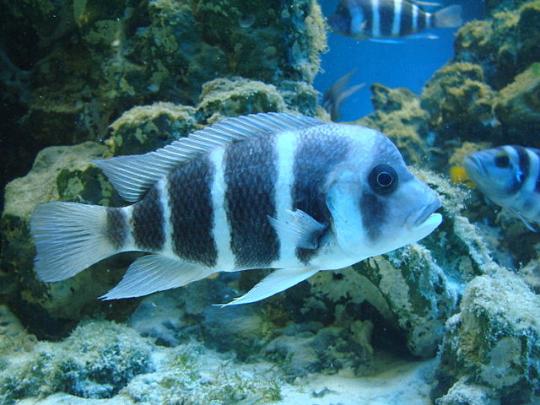Frontosa
Guest Post by FishTankSetups.com
Brief Summary
- Origin: Cyphotilapia frontosa, generally termed as frontosa is a member of the cichlid family. They are originally found in the freshwaters of Tanganyika Lake in East Africa.
- Max Size and Age:The adult frontosa can grow up to 12 inches in length in an aquarium. Females are a little smaller with a maximum size of 10 inches. Similar to other species in the cichlid family, frontosa can live for 15-20 years.
- Types of frontosa: There are two major categories of frontosa, Cyphotilapia frontosa and C. gibberosa. Kigoma and Burundi are the two most common varieties of Cyphotilapia frontosa. Gibberosa can be classified further into two varieties, Tanzanytes and Zaires. Kigoma variety can be easily identified by the prominent 7 stripes on its body. Burundi can be recognized by the giant lump and the prominent straight stripe down the eyes. Tanzanyte Gibberosa is bluer in color. They have a mask like pigmentation around their eyes extending to the jaws. Zaires are the most expensive varieties and can be distinguished from other varieties by the mask around their eyes that does not extend past the eyes.
Frontosa Tank Size and Setup
Minimum tank size for a single adult frontosa should be 70 gallons. If you want to add more tank mates then you must change into a larger tank with approximately 120-gallon size. The water conditions should be checked from time to time and good filtration is a must. You can invest in a good quality dry/wet filter or a canister filter as they clean the water and also provide water movement. The pH level should be kept at 7.8- 9.0 range. The most favorable water temperature for frontosa should be around 72-820F. Also, frontosas dwell at the bottom of the lakes and waterways in the wild. They are mouth breeders and keep the eggs in their mouth for quite some time. After a few weeks, the females spit out the eggs and keep them in hiding. They again place the eggs in their mouth at night or if they sense any kind of danger. So, adding some rock or cave at the bottom would be an excellent option to create the most favorable living and breeding conditions for frontosa.
Best Food for Frontosa
Frontosas are carnivorous or to be more specific, "piscivorous" in nature. That means they love to eat live smaller fishes. But you can also feed them other live foods like brine shrimps, bloodworms and other saltwater specimen. This will reduce the chances of contamination or infection. They have big mouths so if you choose to feed them ready-made packaged foods you must ensure that the granules or the pellets are bigger in size. Giving a balanced nutritious food is important for keeping good health and longer life for your frontosa. Try out different varieties of live saltwater fishes, worms, frozen foods and flake foods. You can feed them as per your own schedule and timing. But avoid feeding them at night. It is best to give them sufficient food once daily. If you prefer feeding them twice a day then make sure the quantity of food is lesser.
How to Keep Frontosa Healthy and Care Tips
It needs a moderate level of care for frontosas. If you provide a healthy diet and maintain your tank twice a week, then your frontosa will grow and live healthy for years without any hassles. It is best to add a layer of sand and pebbles as these fishes prefer living in the bottom. They also need some space to hide the eggs so adding some stones or weeds will be great. You should also take care of the filtration and the heating arrangements. They live in social groups in the wild so it is best to club a few frontosas together in a tank.
Frontosa Tank Mates
Frontosa is not aggressive but at times, is territorial in nature. They are usually gentle with tankmates of other species. Frontosa prefer to stay at the bottom of the water level so larger fishes that are top swimmers can easily be added to the tank. If you want to breed frontosa in your aquarium you should keep 5-6 females and a single male together. If the water conditions and good and the tank setup is appropriate, then it might create an excellent opportunity for breeding.
Final Thoughts
Frontosa is one of the most sought after species for the breeders and hobbyists. They are rare and the original varieties are found deep beneath the water. This makes them pretty expensive too. However, most of the varieties are farm-bred but they are equally beautiful like the wild specimen. Also, you must ensure providing a larger tank, filtered water and nutritious food throughout their lifetime. So, consider these factors before purchasing frontosas for your aquarium.

